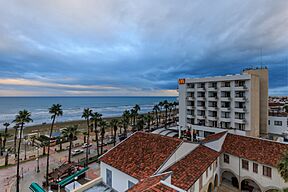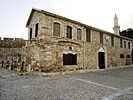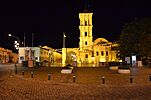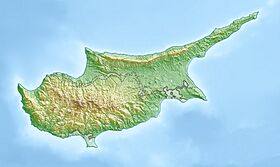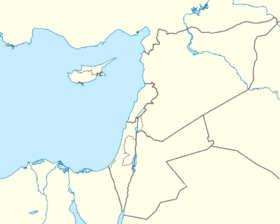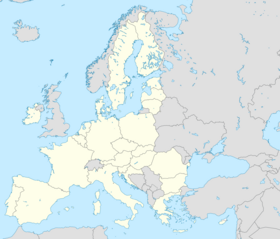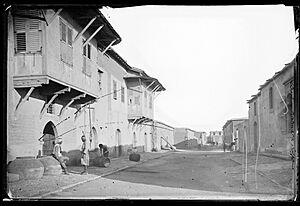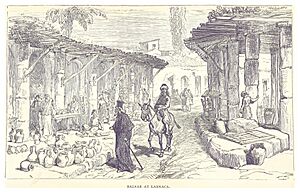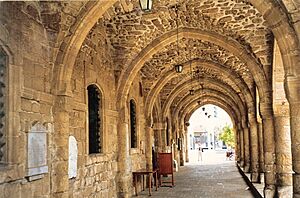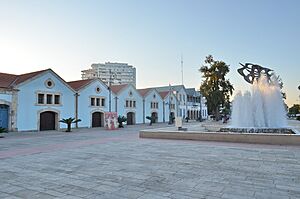Larnaca facts for kids
Quick facts for kids
Larnaca
|
|
|---|---|
|
City and municipality
|
|
|
Finikoudes Promenade
Hala Sultan Tekke
Larnaca Marina
Larnaca Castle
St Lazarus Church
Larnaca District Administration
Kamares Aqueduct
|
|
| Nickname(s):
"Skala"
from Greek: "Σκάλα"; in Turkish: "İskele" |
|
| Country | |
| District | Larnaca District |
| Government | |
| • Type | Municipal council |
| Area | |
| • Municipality | 32.85 km2 (12.68 sq mi) |
| • Urban | 118.62 km2 (45.80 sq mi) |
| Elevation | 26 m (85 ft) |
| Population
(2021)
|
|
| • Municipality | 52,038 |
| • Rank | 4th municipality, 3rd urban in Cyprus |
| • Urban | 120.000 |
| • Urban density | 1.01163/km2 (2.62012/sq mi) |
| • District | 155,753 |
| Demonym(s) | Larnacan(s) (en) Larnakiotis, (masc.), Larnakiotissa (fem.) (gr), Skaliotis, (masc.), Skaliotissa (fem.) (gr, colloquial) |
| Time zone | UTC+2 (EET) |
| • Summer (DST) | UTC+3 (EEST) |
| Post code |
6010-6060
|
| Area code | 24 |
| Patron saint | Saint Lazarus (12 April 2025) |
| Major airport(s) | Larnaca International Airport |
Larnaca, also spelled Larnaka, is a lively city on the southeast coast of Cyprus. It is the main city of the Larnaca District. In 2021, the district had about 155,000 people. This makes Larnaca the third largest city in Cyprus, after Nicosia and Limassol.
Larnaca was built on the ancient city of Citium. This old city was famous as the birthplace of Zeno of Citium, a philosopher who started the idea of Stoicism. Today, Larnaca is home to many important places. These include the Church of Saint Lazarus, Hala Sultan Tekke, and the Kamares Aqueduct. You can also visit the Larnaca Castle and interesting museums like the Larnaca District Archaeological Museum.
Many people visit Larnaca for its beautiful beaches. The city's famous seafront, called Finikoudes, is lined with palm trees. Larnaca also has the main airport for Cyprus, Larnaca International Airport. It also has a busy seaport and a marina for boats.
Contents
What's in a Name?
The name Larnaca comes from an old Greek word, larnax. This word means 'coffin' or 'chest'. Many old coffins, called sarcophagi, were found in the area. This is why some people think the city got its name. An archaeologist named Sophocles Hadjisavvas said that a consul in the late 1800s found over 3,000 tombs in the Larnaca area.
The city is also sometimes called "Skala." This Greek word means 'ladder' or 'port'. In Turkish, it's called "İskele." This name used to refer to the city's old port. Today, it's the name of the area around the port.
A Look at Larnaca's Past
The ancient city of Kition was first built around 1300 BC. New styles of pottery and buildings appeared between 1200 BC and 1000 BC. This suggests that the Achaeans, who were early Greek settlers, arrived in Kition. Around the same time, people from Phoenicia also settled there.
Archaeologists have found remains at the Kiteon sites from the 13th century BC. Around 1000 BC, the Phoenicians rebuilt Kition. It became an important center for their culture. The ruins include huge walls and a group of five temples, plus a port for ships.
Over many centuries, powerful empires took control of Kition. First, it was part of the Assyrian Empire, then Egypt. Like most cities in Cyprus, Kition later belonged to the Persian Achaemenid Empire. In 450 BC, the Athenian general Cimon died at sea while helping a revolt against Persia. He asked his officers to keep his death a secret.
Strong earthquakes hit the city in 76 AD and again in 77 AD. Even bigger earthquakes in 322 AD and 342 AD destroyed Kition, Salamis, and Pafos. Kition's harbor became filled with mud, and people moved to the seafront further south. Earthquakes, cutting down too many trees, and animals eating too much grass likely caused the harbor to fill up.
During the Ottoman Period, which began in 1571, the main commercial port was in an area called Skala. This area is just south of the Larnaca Castle.
Nature and Weather
The Larnaca Salt Lake fills with water in winter. Many flamingos visit the lake from November until March. The lake usually dries up in the summer. In the past, people collected good quality salt from its dry surface. However, the salt from the lake is not used for eating anymore.
Larnaca's Climate
Larnaca has a hot, semi-dry climate. This means it gets little rain each year and has very hot summers. Sometimes, it's also called a Mediterranean climate because winters are humid and summers are dry. However, it doesn't get enough rain to be fully a Mediterranean climate.
| Climate data for Larnaca (Larnaca International Airport) (1991–2020 normals, extremes 1881-present) | |||||||||||||
|---|---|---|---|---|---|---|---|---|---|---|---|---|---|
| Month | Jan | Feb | Mar | Apr | May | Jun | Jul | Aug | Sep | Oct | Nov | Dec | Year |
| Record high °C (°F) | 24.0 (75.2) |
26.2 (79.2) |
30.7 (87.3) |
34.1 (93.4) |
40.6 (105.1) |
41.5 (106.7) |
41.1 (106.0) |
40.9 (105.6) |
39.7 (103.5) |
34.8 (94.6) |
31.5 (88.7) |
26.6 (79.9) |
41.1 (106.0) |
| Mean daily maximum °C (°F) | 17.1 (62.8) |
17.5 (63.5) |
19.9 (67.8) |
23.0 (73.4) |
27.0 (80.6) |
30.6 (87.1) |
33.0 (91.4) |
33.3 (91.9) |
31.4 (88.5) |
28.3 (82.9) |
23.3 (73.9) |
18.9 (66.0) |
25.3 (77.5) |
| Daily mean °C (°F) | 12.4 (54.3) |
12.6 (54.7) |
14.5 (58.1) |
17.6 (63.7) |
21.7 (71.1) |
25.3 (77.5) |
27.8 (82.0) |
28.2 (82.8) |
26.0 (78.8) |
22.9 (73.2) |
18.2 (64.8) |
14.3 (57.7) |
20.1 (68.2) |
| Mean daily minimum °C (°F) | 7.8 (46.0) |
7.6 (45.7) |
9.1 (48.4) |
12.1 (53.8) |
16.4 (61.5) |
20.1 (68.2) |
22.6 (72.7) |
23.0 (73.4) |
20.6 (69.1) |
17.5 (63.5) |
13.2 (55.8) |
9.7 (49.5) |
15.0 (59.0) |
| Record low °C (°F) | −0.9 (30.4) |
−1.3 (29.7) |
−1.0 (30.2) |
2.0 (35.6) |
8.5 (47.3) |
12.5 (54.5) |
16.0 (60.8) |
15.6 (60.1) |
12.4 (54.3) |
7.6 (45.7) |
1.9 (35.4) |
0.6 (33.1) |
−1.3 (29.7) |
| Average precipitation mm (inches) | 83.2 (3.28) |
47.4 (1.87) |
30.3 (1.19) |
15.8 (0.62) |
11.5 (0.45) |
2.1 (0.08) |
0.7 (0.03) |
0.4 (0.02) |
5.2 (0.20) |
16.0 (0.63) |
42.0 (1.65) |
95.4 (3.76) |
350.1 (13.78) |
| Average relative humidity (%) | 72 | 71 | 68 | 65 | 63 | 64 | 67 | 66 | 61 | 60 | 64 | 72 | 66 |
| Mean monthly sunshine hours | 181.4 | 189.4 | 243.0 | 273.6 | 338.4 | 378.6 | 394.4 | 370.3 | 314.7 | 272.5 | 214.5 | 177.1 | 3,348 |
| Source 1: NOAA | |||||||||||||
| Source 2: Meteo Climat (record highs and lows) | |||||||||||||
Finikoudes Promenade
Finikoudes is a beautiful walkway along the seafront. It's famous for the rows of palm trees that line both sides. The Greek name for these palm trees is foinikoudes.
Many fun activities happen on the promenade during big festivals. The most important one is Kataklysmos, or the Festival of the Flood. This festival is celebrated in early summer with many cultural events. It used to last about a week. But now, with more shops and food stalls, it lasts about three weeks. During this time, the seafront road is closed to cars in the evenings.
Important Monuments
- A statue of Cimon stands on the Finikoudes Promenade. It has a quote about him that says: "Even in death he was victorious."
- A marble statue of Zeno of Citium is near the American Academy. Zeno was born in Kition in 334 BC. He studied philosophy in Athens and later started the Stoicism school of thought.
- The Armenian Genocide Memorial is on Athenon Avenue. It was unveiled in 2008.
Famous Landmarks
Larnaca has many well-known landmarks. These include the historic Church of Saint Lazarus and the Catacomb of Phaneromeni Church. You can also see the Hala Sultan Tekke, the old Bekir Pasha Aqueduct, and the Larnaca Castle.
Larnaca's Economy
Larnaca's economy has grown a lot since 1975. This happened after the Port of Famagusta was lost and Nicosia International Airport closed. These events made Larnaca's airport and seaport much more important for the island's economy. The Larnaca Airport recently had a big upgrade costing €650 million.
Most jobs in Larnaca are in the service industry, including tourism. About three-quarters of the city's workers are in this sector. Many travel companies have their main offices in Larnaca. Also, big companies like Bank of Cyprus, Hellenic Bank, and KPMG have bases here. Larnaca has the second largest port in Cyprus and one of the biggest malls, Metropolis Mall.
Learning in Larnaca
Larnaca has over a hundred schools and learning centers. These include the American Academy and the Larnaca Nareg Armenian school. There are also universities like the American University and UCLAN Cyprus University.
Culture and Arts
Arts
Larnaca has a theater and an art gallery run by the city. The Cornaro Institute was a cultural center in the Old Town. It was started by artist Stass Paraskos in 2007. It showed modern art and held other cultural events. It closed in 2017.
Music
The city has its own music groups, like the Municipal Wind Orchestra.
Sports
Larnaca has several football teams, including AEK Larnaca FC and ALKI Larnaca FC. Because of past events in Famagusta, two teams from there, Anorthosis and Nea Salamina, are now based in Larnaca.
Local sports stadiums include AEK Arena - Georgios Karapatakis, GSZ Stadium, Antonis Papadopoulos Stadium, and Ammochostos Stadium.
Larnaca has hosted many international sports events. These include the Larnaka International Marathon since 2017, and the Shooting Shotgun European Championships in 2012. It also hosted the FIVB Beach Volleyball SWATCH Youth World Championship in 2012. The city was home to the European Under-19 Football Championship final in 1998 and the European Under-17 Football Championship final in 1992.
Windsurfers from all over the world come to Larnaca, especially in autumn. Mackenzie Beach has a windsurfing center and a center for extreme sports.
Museums
Larnaca has many interesting museums. Some of them are the Larnaca District Archaeological Museum and the Pierides Museum. Other museums include the Agios Lazaros Byzantine Museum, Larnaca Medieval Museum, and the Larnaca Municipal Museum of Natural History.
Delicious Food
The beaches in Larnaca have many seafood restaurants. While there are also many international restaurants, visitors love to try the local food. Many traditional dishes use beans. For example, fasolaki is French beans cooked with lamb in red wine. Louvi me lahana is black-eyed peas with chard.
Some common appetizers are potato salad, kohlrabi salad, and hot grilled black olives. The next course might include Cyprus village sausage and sheftalia. You might also find dolmades (stuffed grape leaves) and keftedes (meatballs). Other dishes include kolokassi in tomato sauce and various eggplant dishes. Baked or grilled lamb, called souvla, is often served. Fish dishes are also very popular.
City Areas
Some of Larnaca's neighborhoods are Skala, Prodromos, Faneromeni, Drosia, Kamares, Vergina, and Agioi Anargyroi.
Getting Around
The main ways to travel to and from Larnaca are through Larnaca International Airport and Larnaca Port. The airport is the busiest in the Republic of Cyprus, and the port is the second busiest.
Public Transport
You can get around Larnaca using only buses. A bus fare costs 2.40 in cash. Larnaca offers many bus options for travel from Larnaca International Airport and the Larnaca central station.
Global Connections
Sister Cities
Larnaca is connected with many cities around the world. These are called "twin towns" or "sister cities."
 Acapulco, Mexico (since 2011)
Acapulco, Mexico (since 2011) Ajaccio, France (since 1989)
Ajaccio, France (since 1989) Bratislava, Slovakia (since 2013)
Bratislava, Slovakia (since 2013) Galaxidi, Greece (since 2005)
Galaxidi, Greece (since 2005) Giannitsa, Greece (since 2003)
Giannitsa, Greece (since 2003) Glyfada, Greece (since 1998)
Glyfada, Greece (since 1998) Ilioupoli, Greece (since 2000)
Ilioupoli, Greece (since 2000) Larissa, Greece (since 1990)
Larissa, Greece (since 1990) Leros, Greece (since 2000)
Leros, Greece (since 2000) Marrickville, Australia (since 2005)
Marrickville, Australia (since 2005) Piraeus, Greece (since 1999)
Piraeus, Greece (since 1999) Poti, Georgia (since 1987)
Poti, Georgia (since 1987) Sarandë, Albania (since 1994)
Sarandë, Albania (since 1994) Szeged, Hungary (since 1993)
Szeged, Hungary (since 1993) Tarpon Springs, U.S. (since 2009)
Tarpon Springs, U.S. (since 2009) Tianjin, China (since 2007)
Tianjin, China (since 2007) Tulcea, Romania (since 2003)
Tulcea, Romania (since 2003) Venice, Italy (since 2010)
Venice, Italy (since 2010)
Consulates
As of October 2024, Larnaca hosts 2 consulates general and 13 consulates from different countries.
 Afghanistan
Afghanistan Albania
Albania Bangladesh (consulate general)
Bangladesh (consulate general) Bosnia and Herzegovina
Bosnia and Herzegovina El Salvador
El Salvador France
France Gambia
Gambia Italy
Italy Morocco (consulate general)
Morocco (consulate general) Philippines
Philippines Portugal
Portugal Saint Vincent and the Grenadines
Saint Vincent and the Grenadines Sri Lanka
Sri Lanka Tunisia
Tunisia Uganda
Uganda
Famous People from Larnaca
Many notable people have come from Larnaca:
- Zeno of Citium (born around 334 BC) – A famous philosopher who founded Stoicism.
- Apollonios of Kition (1st century BC) – A doctor known as "the Cypriot Hippocrates."
- Ebubekir Pasha (1670 – 1757/1758) – A governor of Larnaca who was also a kind person.
- Demetrios Pieridis (1811–1895) – He started the Pierides Museum.
- Dimitris Lipertis (1866–1937) – A national poet.
- Neoclis Kyriazis (1877–1956) – A doctor and historian.
- Mehmet Nazim Adil (1922–2014) – A religious leader born in Larnaca.
- Kyriacos A. Athanasiou – A Cypriot-American academic and business person.
- Stass Paraskos – A well-known artist.
- Mihalis Violaris – A singer and composer who made Cypriot music popular in Greece.
- Giorgos Theofanous – A composer.
- Anna Vissi – A famous singer.
- Loucas Yiorkas – A singer who won The X Factor in 2009.
- Ada Nicodemou – An actress.
- Garo Yepremian – An Armenian-Cypriot former American football player. He was part of the 1972 Miami Dolphins, the only NFL team to have a perfect season.
- Chrystalleni Trikomiti – A rhythmic gymnast who won a gold medal at the Commonwealth Games.
- Martino Tirimo – A Cypriot classical pianist.
- Tio Ellinas – A Cypriot racing driver.
Images for kids
See also
 In Spanish: Lárnaca para niños
In Spanish: Lárnaca para niños
- Larnaca District
- Kittim
- Chryspolitissa Orthodox Church


